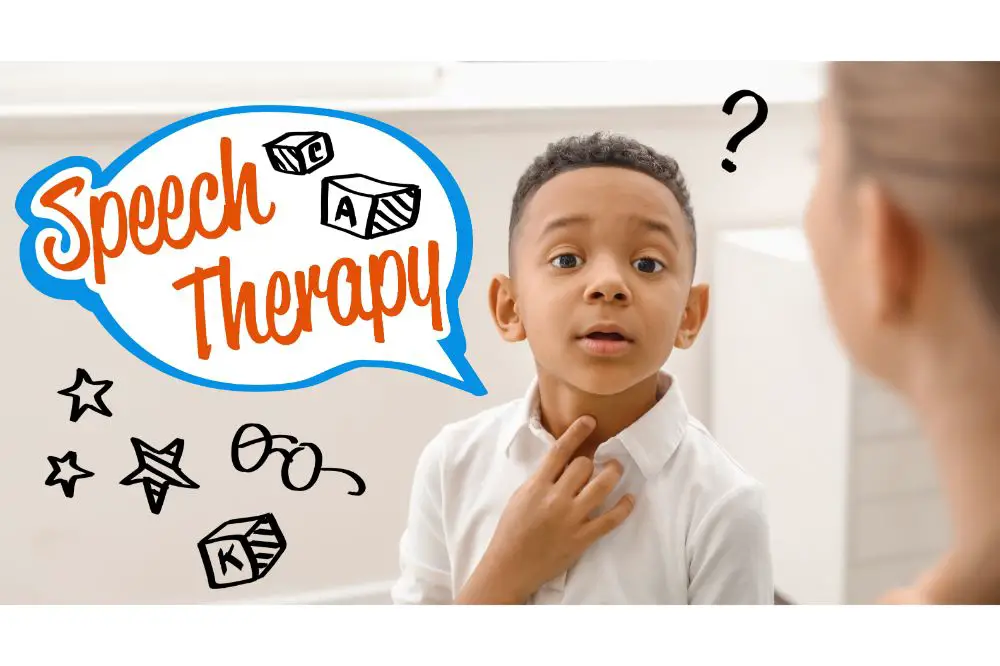When your child experiences speech delay, you may want to know how long does speech therapy take to work before going to a therapist.
Speech therapy does not work overnight but is a complex process with multiple dimensions. Several issues can and will increase or decrease the duration of the treatment.
The nature of your child’s challenge, your involvement, and the competency of the therapist are some of the deciding factors.
If your child has other learning challenges along with speech delay, the therapy might take longer to work.
How Long Does Speech Therapy Take?
If you’re starting speech therapy for your child, you want to maximize the effectiveness of the process.
One way to do that is to learn about all the variables in this equation and focus on them to get the fastest results.
The Nature of Speech Challenge
The nature of the challenge a child faces has a significant impact on their therapy duration.
Even in a single subcategory, there could be multiple variables.
A child may have difficulty with speech clarity, or they might have challenges in processing language. Others might have problems expressing thoughts.
Some children have receptive language problems, which compromise their comprehension abilities. Others may have a speech articulation disorder.
Fluency is another challenge a child may face. For each problem, the therapist may set different goals that specifically target a challenge.
If there are multiple challenges, the therapy may take longer as the therapist works to understand the intensity of each one.
Two kids diagnosed with the same challenge may need completely different treatment, as each child comprehends the language differently.
Only after a thorough review can a therapist come up with effective strategies and help a child deal with his speech problems.
The Severity of Challenge
Generally, the intensity of speech disorders means a longer therapy duration, but there are exceptions to this rule.
The severity of the speech challenge is situational, meaning a therapist must address underlying problems first.
For example, a child who stutters may only have problems speaking in front of a group of people and does not stutter with parents.
Others might have trigger words or anxiety disorders that prevent them from recovering faster than their peers with the same diagnosis.
Sometimes, such a problem is exacerbated when a child is nervous or excited. However, once the child is calm, the stuttering recedes.
That’s why it’s crucial to analyze the intensity and severity of the challenge under different circumstances.
Associated Challenges
Most children who have speech disorders also suffer from other associated challenges.
For example, autism is a big reason for speech delay, but that does not mean every child with a speech problem suffers from autism.
In kids with autism, speech therapy will take longer to take effect as the therapist has to address multiple challenges simultaneously.
Similarly, a child with apraxia of speech has their movements disoriented while speaking, which increases the therapy time.
The critical thing to remember here is to do a complete evaluation of the child to see if there are additional behavioral or occupational challenges.
It’s also important to mention these challenges to the therapist so they can make a comprehensive strategy for speech therapy.
When a child has more than one behavioral challenge, the therapy takes longer because the child recovers slowly.

The Competency of the Therapist
It’s vital to ascertain the credentials of the speech pathologist before you decide to start therapy for your child.
A competent pathologist has expertise and experience in the field of hearing and speaking and can easily demonstrate how they are the best choice for your child.
Do not shy away from asking about their skills, research, and qualifications before making a decision.
The American Speech-Language-Hearing Association (ASHA) issues a Certificate of Clinical Competence to help parents choose from the best pathologists.
Additionally, each state has an office of professions that regulates the field of speech pathology.
These regulations and certifications are a good start for your peace of mind, but you cannot just rely on these credentials.
Your child might have a unique problem that only a specifically qualified professional can address.
Make sure to do your research and choose the pathologist with the most experience.
The competence of the therapist will considerably reduce the time of therapy and will also save you money.
The Frequency of the Therapy Sessions
The frequency of the therapy sessions affects how long your child will need therapy, and so does the duration of each session.
A child who receives therapy twice a week is likely to improve faster than the one who gets it once a week.
However, the time and frequency of therapy sessions depend on the nature of the problem and how much a child learns between two consecutive sessions.
A therapist may increase or decrease the time and frequency of the sessions after starting the therapy and evaluating the preliminary results.
Some children may need four or five sessions a week to recover from their challenges; even then, the therapy may take months.
In general, frequent and longer speech pathology sessions yield faster results and help children more.
The Involvement of Parents
A therapist can set goals, make strategies, and use pathology techniques to improve your child’s speech. However, they cannot work round the clock.
The parents’ involvement is key to speeding up the therapeutic process as they attend to the child most of the time.
The therapist will spend the starting weeks of the therapy building rapport with your child and developing helpful routines.
Later, they should involve you in those strategies, goals, and techniques to improve your child’s speaking skills.
Most of the recovery takes place outside the therapy sessions, so parents should involve themselves as much as possible.
Plus, only you can tell the therapist about the details that can help the recovery process. Things like what your child likes, what they don’t like, what motivates them, etc.
With such details and continuous efforts of the parents and the therapist, the speech therapy process becomes even more effective.
What’s more, you’ll see visible improvement within weeks.
Books for Parents to Learn About Speech Disorders
As mentioned, the involvement of parents is the key to a successful and speedy recovery from speech disorders.
For that, you can benefit from these top-quality books to increase your understanding of the challenges your child faces and how to help them.
1. Introduction to Children with Language Disorders
The Introduction to Children with Language Disorders is a valuable resource for learning about language disorders in children.
It starts with an introduction to language development in children and explains how children acquire comprehension and expression of language.
After explaining what language development is, the book then describes how some children cannot develop those skills with age.
It also talks about the challenges in different age groups, with a comparative analysis to give you the severity of the problem faced by your child.
The current edition has all the latest research and federal education laws to help you easily navigate your child’s education process.
2. Children’s Speech: An Evidence-Based Approach to Assessment and Intervention
The Children’s Speech is another awesome book for Speech-Language Pathologists (SLPs) and parents to understand the challenges deeply.
Although it’s a textbook for SLPs, parents can also read it to get a better understanding and deeper knowledge of their child’s challenges.
Plus, the book has evidence-based strategies, analyses, and assessments to help you speed up the recovery process.
The book contains intervention principles, goals, plans, and information about speech disorders with appropriate treatments.
3. Language Disorders from Infancy through Adolescence
The Language Disorders from Infancy through Adolescence is one of the best books to learn about language disorders.
It helps the reader understand the basics of language development and how a child picks up basic vocabulary, language understanding, and expression.
The book also covers preschool and school-age kids, with relevant assessments and analyses to compare your child’s speech abilities.
Apart from a theoretical perspective, the book also offers practical guidance so that you can set goals and make plans for speech therapy.
The Bottom Line
Parents want to know how long does speech therapy take so that they can prepare for and plan their child’s sessions from start to finish.
While you cannot determine the exact time at the start of the therapy, some factors may help speed up the process.
The best approach is to consult a speech and language pathologist as early as possible and to set realistic goals for the child.
The parents’ role is highly important, too. They should learn about speech disorders and provide an enabling environment for the therapy to work.




